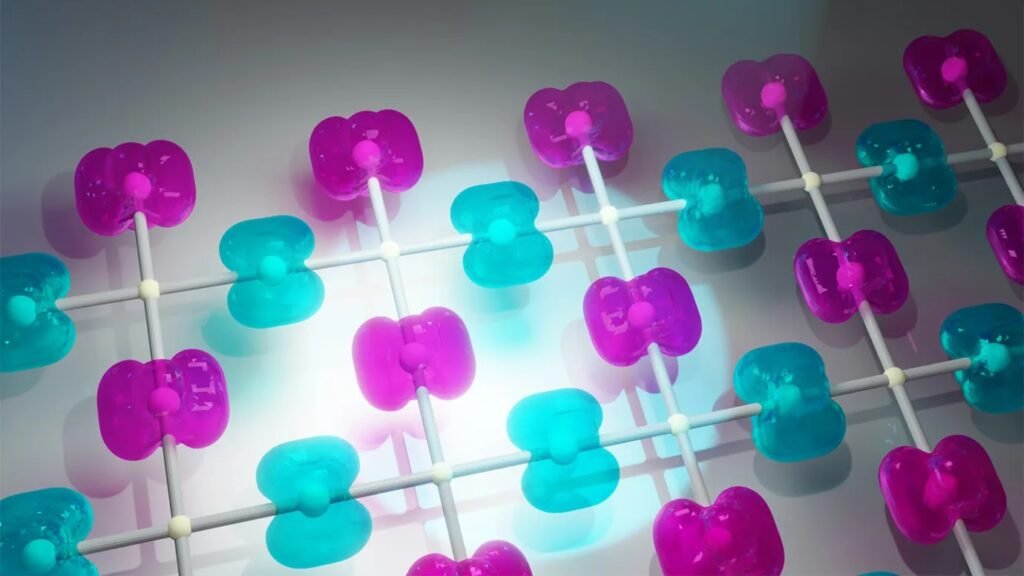A new type of magnet material, the altermagnetic material, was discovered. It can be used in computers’ hard drives.
Source: ScienceNews
Physicists have reported a new class of magnetic materials called altermagnets, which could lead to new technologies such as faster, more efficient computer hard drives.
The study of magnetic materials is an ancient science. Ferromagnets have been known for thousands of years. Lodestone, a magnetized form of the mineral magnetite, fascinated the ancient Greeks. The Chinese forged the magnetized mineral into the first compasses in the fourth century B.C. Antiferromagnets were discovered in the 1930s.
Then, a few years ago, theoretical predictions suggested altermagnets could exist. And when scientists began searching for them, researchers quickly discovered that the magnetic materials were real and plentiful.
On a microscopic level, materials get their magnetism from their atoms. The atoms have spin, a quantum mechanical property bestowed by the atoms’ electrons. That spin makes each atom act like a minuscule magnet. The spins can point in different directions, normally called spin up and spin down. Any material with spins arranged in an orderly way — in the absence of any externally imposed magnetic field — is considered a magnetic material by physicists.

Until now, magnetic materials were divided into the following categories:
- Ferromagnetic: are strongly magnetized by an external magnetic field, the magnetization persists partially when the external magnetic field is removed. These materials have magnetic domains, regions where atoms’ magnetic moments align in one direction. The most known materials in this category are iron, cobalt, nickel, and alloys with these elements.
- Paramagnetics: an external magnetic field can align the magnetic dipole moments and magnetize the material. However, after removing the magnetic field, the material is demagnetized. Some examples are rare earth, aluminium and sodium.
- Diamagnetics: are materials lightly repelled by a magnetic field. When receiving an external magnetic field, they produce a magnetic field in opposite direction, when the external field is removed, they go back to original state. All materials have diamagnetism, because electrons orbit the nucleus and their motion produces a small magnetic field, electrons with opposite spin produce magnetic fields that cancel each other. However, in other types of materials, the different effects are stronger than diamagnetism. Some examples of this category are bismuth, water, silicon and gold.
- Antiferromagnetics: have magnetic domains with magnetic moments in opposite directions, but become parallel to an external field.
- Ferrimagnetics: dipole moments in opposite directions, inside the dominion in material, only cancel partially.

In altermagnets, the atoms’ spins alternate, but with an added twist. Not only are the spins of neighboring atoms opposite, but the atoms also have different moment direction.

If you take an altermagnet, flip its spins around, and rotate the material — by 90 degrees, for example — it will look identical to its original state. That’s a special type of symmetry, different from other magnetic materials. And this symmetry puts altermagnets in their own class, Jairo Sinova of Johannes Gutenberg University Mainz and colleagues argued in Physical Review X in September 2022 — one of a smattering of theoretical papers since 2019 that helped put altermagnets on the map.
Experiments have now begun confirming the altermagnetic identities of certain materials.
Scientists predicted that the electrons within altermagnet materials would have some unusual characteristics. To confirm the altermagnetic nature of a given material, scientists need to map out that electron behavior. Particularly important is plotting out how the energy of an electron in the material relates to its momentum. In ferromagnets, electrons with a given energy on that map split up: The momentum depends on the spin. Spin up electrons will have a different momentum than spin down electrons of the same energy.
In antiferromagnets, however, spin up and spin down electrons are the same. For a given energy, both spins will have the same momentum.
Here’s where altermagnets’ weird dual nature comes into play. Scientists predicted that the materials’ electrons would be split according to spin, but only for electrons moving in certain directions. That means, in some orientations the material will act like a ferromagnet, and in others like an antiferromagnet.
To confirm this effect, scientists used a technique called angle-resolved photoemission spectroscopy, which measures the electrons emitted when a material is hit with light. With that method, researchers observed spin splitting in the material manganese telluride. The material has been studied since the 1960s and was previously thought to be well understood as an antiferromagnet. But the results matched predicted altermagnetic behavior, researchers reported in the Feb. 15 Nature.
Other research teams found altermagnetic properties in ruthenium dioxide and in a compound of chromium and antimony.

Possible application of altermagnet
Currently, ferromagnets are used for magnetic computer hard drives, which encode 0s and 1s in tiny magnetic bits. But the technology is limited by ferromagnets’ magnetic fields.
Magnetic bits are difficult to pack tightly: Ferromagnets placed in close proximity can interfere with one another via their magnetic fields. And the magnetic bits have a speed limit: They can be switched from 0 to 1 only so fast. So, scientists had considered replacing ferromagnets with antiferromagnets, which have no magnetic field. But there’s a problem with that plan. To read out data, hard drives take advantage of the spin-splitting behavior of ferromagnets. In antiferromagnets, electrons don’t split up according to spin.
Altermagnets, which have no net magnetic field but do split electrons by spin, could provide the best of both worlds. Altermagnetism “seems to remedy some of the key limitations of ferromagnets,” says physicist Tomáš Jungwirth of the Institute of Physics of the Czech Academy of Sciences.
What’s more, whereas ferromagnets tend to be metals, altermagnets can be made of a variety of material types. Manganese telluride, for example, is a semiconductor. Because semiconductors are used to make computer chips, scientists hoped that a magnetic material that is also a semiconductor might allow for the possibility of combining a memory and processor in one material.


